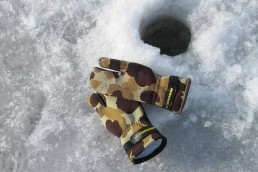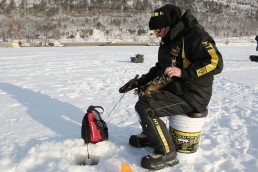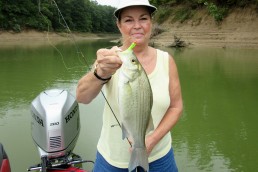Ten Secrets for Keeping your Hands Warm
SHARE THIS POST
After safety, there’s no question one of the biggest concerns is comfort on the ice. Although recent advances in cold-weather clothing have undoubtedly made this less of an issue, keeping all extremities warm can be a challenge, and one that presents a recurring problem for many.
Aside from minimizing exposure, here are ten tips to help alleviate this struggle and remain comfortable:
1. Don’t skip breakfast.
Food helps keep your metabolism churning, allowing the body to produce heat. Be sure to start every ice outing with a hearty breakfast. While I’m not promoting overeating or consuming a high-calorie diet rich in carbs or fats, this is one-time logical exception to the rule. High-calorie, high-carb sources such as hash browns, donuts, pastries, pancakes and buttered toast, or slow-burning fats like bacon or sausage that are digested gradually over extended periods, provide a solid base and stoking your metabolic furnace and helping generate body heat. This is important, as our bodies continually burn calories just to fight the cold. Added movement, such as actively drilling multiple holes and moving from location to location through deep snow, also burn a large number of those calories.
2. Stay hydrated.
Remaining hydrated is critical, because proper hydration acts as a catalyst to feed metabolism. However, be smart about this—stick with water or fruit juices. Avoid caffeinated sodas and coffee, as caffeine is a diuretic, meaning it encourages the body to expel water, promoting dehydration, which is the exact opposite outcome anglers want. Also note that alcohol may feel warm when initially consumed. But it actually lowers body temperature so if your priority is to remain warm, avoid drinking alcohol.
3. Wear a hat.
Warm air rises, and when it comes to heat, the body essentially acts as a chimney and heat escapes readily through an uncovered head. As your body cools, your system responds by retaining blood within the vital organs and core where heat retention is more critical, consequently reducing flow to the hands and fingers. A warm stocking hat blocks this process, helping retain heat and keeping your core temperature elevated. As a result, the body continues sending warm blood to your extremities, meaning your hands and fingers stay warmer, longer.
4. Go with mitts.
I’ve spent hundreds of hours on the ice in some pretty severe weather, and found wearing mitts keeps hands and fingers warmer than gloves. Keeping fingers together within a larger pocket of insulated air helps maintain warmth, as opposed to having gloved fingers divided into individually separated, cramped spaces where heat is more readily dispersed.
5. Keep liners and skin dry.
This may be common knowledge, but be sure to keep your mitts’ liners directly in contact with your skin dry. The combination of wet materials and cold, dry air promotes evaporation, a cooling process that rapidly accentuates heat loss. Always keep your skin surface dry to eliminate evaporation. Carry at least one spare pair of mitts, and if possible, extra liners too. Never hesitate to use them at the first sign of wet skin. At some point you will likely be handling fish, which if intended for release, shouldn’t be touched with mitts because this practice removes excessive amounts of protective slime coating their skin, leaving fish vulnerable to infections that often result in serious injury or death. Given this, is one justified time to remove your mitts. The best solution is to carry a hand towel to wipe away not only water, but also fish slime, which seems to accentuate obvious heat loss from bare hands.
Are you enjoying this post?
You can be among the first to get the latest info on where to go, what to use and how to use it!
6. Activate those hand warmers.
Placing a disposable hand warmer inside your mitts, along with a second one at each wrist where blood vessels are close to the skin surface, allows heat to be rapidly absorbed and transferred directly to hands and fingers. Larger packs produce more heat, so during extreme cold, using foot- or body-sized warming pads can provide additional comfort. I usually keep a third activated set inside a side pocket as well, so if I remove my mitts for any reason and inadvertently leave them laying somewhere, I have the option of sticking my hands into a warm pocket before going to retrieve them. Keep another pair of hand warmers in a convenient location where they will not only remain dry, but also allow air to circulate around them. Since the packs inside your mitts or pockets have minimal contact with fresh, circulating air from outside, they will lack the oxygen necessary to keep the exothermic chemical reactions inside each pack operating at peak rate, and consequently, cool over time. Periodically exchanging inner pairs with this spare set will ultimately help improve overall hand-warmer performance by keeping the pads exposed to a fresh supply of oxygen, thereby enabling them to continue steadily producing heat.
7. Consider using a muff.
It’s funny how often mitts are removed and mistakenly left behind after eating a sandwich, re-rigging a rod, catching a fish, or, worst of all, left at the scene of a re-set tip-up far in the distance. Should this happen, muffs—especially when disposable hand warmers are added to them and regularly exchanged with a spare pair—help provide another handy way to conveniently slip your hands into warm comfort until you can get back and retrieve that wayward pair of mitts.
8. Avoid contact with cold surfaces.
Obviously, when hands or fingers come into direct contact with metal or any other cold surface, heat will be rapidly drawn away from bare skin. Avoid handling metal tow hitches, pail handles, auger grips, chisels, shelter anchors, skimmers, pliers, mouth spreaders, metal tip-up components, ice rod handles, the cold surfaces of a plastic sled, reels or wet tip-up lines, as all promote rapid heat loss. Even when handling any of these items while wearing mitts, always attempt to dry them off first. This helps prevent moisture from coming in contact with your mitts, which will ultimately cause evaporation.
9. End-of-day maintenance.
It’s all too easy to neglect this critical facet of keeping your hands warm. When leaving the ice, mitts are often left in a sled, on the dash of the truck, or worse yet, simply thrown in a corner when you get home. What’s left to greet you the next morning is an unwelcome pair of wet, chilled mitts. Avoid this by placing each pair on a boot warmer after every outing. After several minutes, they’ll dry thoroughly and you’ll find them comfortably ready for the next day of fishing. Ten minutes or so in a dryer works too. Just be cautious not to leave them in too long because these materials in high temperatures for an extended period, especially polypropylene-type materials, will shrink or be damaged, causing significant reduction insulation. I usually take this process a step further by placing each pair on a boot warmer or in the dryer again for a few minutes just before heading back out. This way, the already warmed liners and mitts won’t absorb precious heat from the activated hand warmers, leaving more heat available to comfort hands and fingers.
10. Use common sense.
After that, it’s really all about common sense. When tending to your tip-ups, rigging rods or re-tying knots, don’t thoughtlessly flick off those mitts and leave the open ends exposed to the wind and loose, blowing snow. Be careful not to place them too close to open holes either, as dry, warm mitts seem to have a strange affinity for finding the open water. Most importantly, don’t try to be a hero and show everyone how tough and cold- resistant you are by not wearing mitts. Just ask anyone who has suffered frostbite or worse. They’ll tell you to always wear those mitts or gloves and minimize exposure of bare skin.
Anglers repeatedly spending long days on the ice each season will be much more comfortable in the short- term following these tips, all the while avoiding more serious concerns like frostbite. And, most importantly, won’t end up paying dearly for these poor decisions later when chronic, life-changing problems such as rheumatism, arthritis or other painful conditions may develop due to a completely unnecessary, largely avoidable series of circumstances and risks.
MWO
SHARE THIS POST
Did you enjoy this post?
You can be among the first to get the latest info on where to go, what to use and how to use it!
Tom Gruenwald
Tom Gruenwald has penned hundreds of informative ice-fishing articles and blogs, been a frequent and popular guest on outdoor speaking circuits, radio and television, has authored four ice-fishing books, and formerly hosted Tom Gruenwald Outdoors, a nationally syndicated television show dedicated solely to the sport of ice-fishing.




